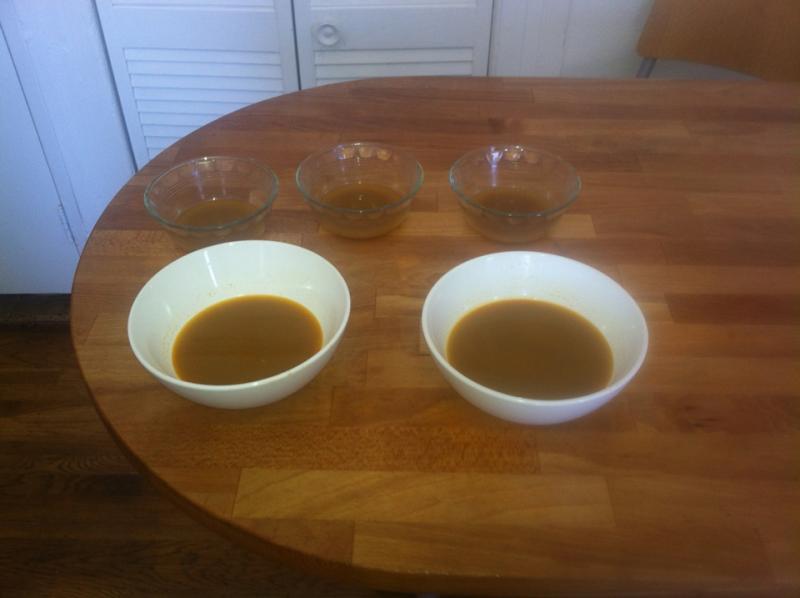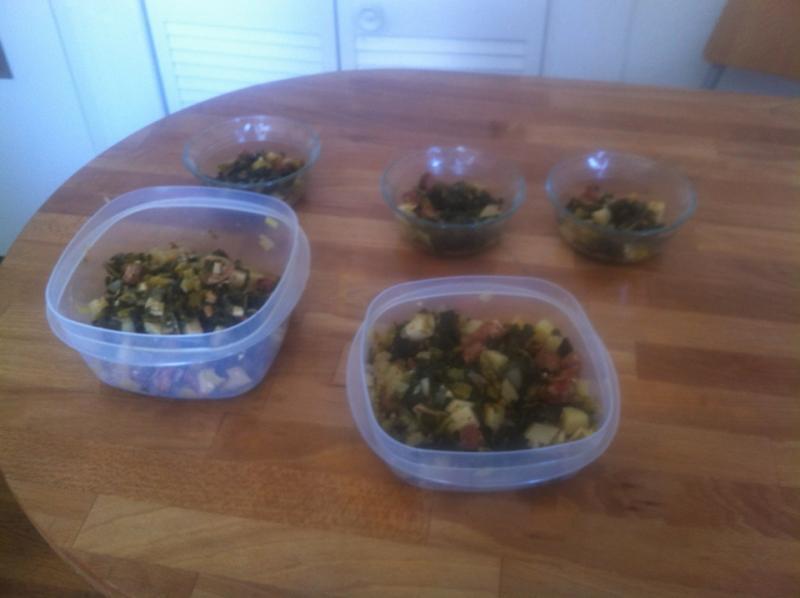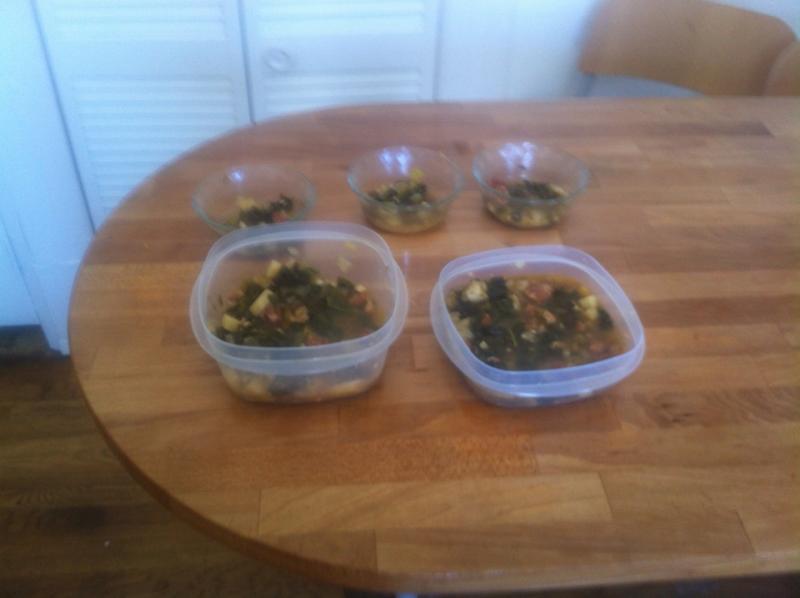-
Posts
3,850 -
Joined
-
Last visited
Content Type
Profiles
Forums
Store
Help Articles
Everything posted by Shalmanese
-

Cool San Francisco restaurants that do online gift cards
Shalmanese replied to a topic in California: Dining
Check out Treatful, run by some friends of mine that is a platform for buying restaurant gift cards. Looks like they currently have about 200 restaurants on there. What kind of restaurant does your friend like? -
Roast or sautee them with some generic flavorings (olive oil, garlic, onions, chili or sesame oil, scallions, garlic, ginger, soy etc). Then freeze them in ziplocks in single serving portions. Once cooked a) they take up a lot less volume and b) they're a lot easier to throw into a dish on a whim. Pasta sauce, omelets, sandwiches, salads, etc. Another thing you can do is make "chips" from certain leafy greens. Kale chips are the most common but you can experiment with other chips as well. Just cook in a low oven until dried and they make great snacks.
-
The new season of Top Chef Masters started last night. What does everyone think of the new season? Personally, I'm disappointed at how this show continues to go downhill. The gimmicks tonight were lame and the "buffet" challenge wasn't really a buffet, it was just the same catering challenge we've seen on every previous TC. I'm fine with crazy challenges with ridiculous constraints but I wish they would up the quality of the judging. James Oseland and Ruth Reichl are as delightful as ever but I don't really feel the need to hear the opinion of a bunch of kids like last season and the quickfire judges are also almost always worthless.
-

Dining out – the rule of diminishing returns
Shalmanese replied to a topic in Food Traditions & Culture
I actually find that there's a canyon of enjoyment in the mid-range of dining out. The times I do go out to eat, I love cheap, ethnic eats under $15 and I appreciate the artistry of a $200 tasting menu but every time I eat at a place that's $25 - $45, I inevitably look down at my plate and think "I'm paying $30 for this I can make this better at home from $5 worth of ingredients!". Just tonight, I was grabbing drinks with a friend at a hip new place that just opened up and she ordered a $22 ricotta ravioli that came with FIVE ravioli and some wild mushrooms and arugula. I'd much rather forgo 6 $30 meals for one $180 meal. -
Virtually every single egg white recipe will say add some cream of tartar to egg whites to help them whip better because the cream of tartar will lower the pH and make it more stable. But if all it's doing is making it more acidic, why exclusively cream of tartar over the dozens of far more common acids found in the kitchen? One difference is cream of tartar is the only solid acid so it wouldn't add more water to the egg whites except many books *also* say that adding a tbsp of water to egg whites increases stability as well. Is there something else in cream of tartar that isn't in other acids?
-
Why no turntable?
-
You may also be mixing too much. Drop dumplings are like muffins in that you don't want to develop too much gluten. Try mixing so that it barely comes together next time and see if you get a better result.
-
Also, the more uneducated the viewer, the easier it is to convince them some $15 plastic doohickey and a $5000 gourmet stove is all that stands between them and gourmet chef status. Educated cooks are harder to sell to.
-

Unacceptable Prices for Trendy Items and Ingredients
Shalmanese replied to a topic in Kitchen Consumer
Some company sells fancy cocktail mixers for $7 a bottle. It's a little bit overpriced but whatever, except they sell simple syrup for the same price. Now that's outrageous! -
Before anyone accuses me of being a more competent chef than I actually am, I'd like to emphasize the possibilities of SV for labor-saving and idiotproofing. Crock pots are rather crass and unreliable devices, and the two settings on mine translate to "Hard boil" and "Not hot enough." It's not strictly necessary to use a PID controller, but since I have one rigged up anyway - why not? I'm an amateur cook who sometimes cooks for groups as large as 25. I'm not even very good at it - I'm lucky to get out of the kitchen in less than three hours on a relatively basic meal. The ability to start two batches of pasta sauce in under an hour then cook them outdoors, in disposable containers, with zero oversight is miraculous; the ability to hold them at a safe 145F indefinitely, even more so. One of the most time-consuming foods I know has now become one of the least. I hate canned food. I'm sick of the price, sick of the taste, and sick of the nutrition. And now, thanks to modern technology, I get to eat a little less. You can't cook vegetables at 145, the cellulose and pectin won't break down at that temperature. It's not clear whether you're making a all-vegetable ragout or vegetable and meat one. As others have noted above, SV meat in a stew is disconcerting and taster usually prefer traditionally braised just because it's more familiar. For vegetables alone, as long as there's no scorching, I'm not sure that hard boiling is neccesarily any different from gentle simmering, apart from more evaporation. It's likely that your crockpot "too low" setting is around 180 - 190F which is generally the accepted SV temp for most vegetables. Evaporation rate is roughly proportional to the surface area of the pan while quantity evaporated is proportional to volume. In a 12" skillet, it might take 30 minutes but a dutch oven would take 2 - 3 hours due to it's greater volume and smaller area. I don't really find much of a point to making small quantities of ragu so I'll generally make mondo batches and freeze. I find I have to reduce the wine by 1/2 separately and use cream instead of milk just to get it the consistency right.
-
Has ‘Organic’ Been Oversized?. the NYT has an article that's long on words but short on actual facts about the process by which organic is defined and how many accuse large companies of systematically and deliberately weakening the standard. It's something that's not surprising to people who have been following the debate but something that deserves more exposure. For the most part, the NYT doesn't grapple with the actual issues. Personally, I don't see something like carrageenan as being something that should be excluded from being organic. Xanthan gum is used in tons of organic foods with no real uproar.
-
Ugh, as much as we all love SV, can we agree that the mania for it has become somewhat obsessive? Let's all step back and take a breath before we head into crazy town. This question was about simmering some nearly expired vegetables, in a pot, for 4 hours. Unless the plan is to Keller up this bitch and SV each vegetable independently at it's correct time and temperature and then strain it pointlessly through 53 chinoises, it's still going to be some simmered vegetables in a pot. Delicious, yes, but not likely to be improved with SV. Next time, just throw them in the slow cooker on low like you planned and it will turn out fine.
-
You can also use them as skewers to grill food and throw the stems in the fire to generate rosemary smoke for foods.
-
I've convinced that recent trends in smartphones and foodblogging has given rise to a generation of "foodies" who are more concerned that something looks pretty than tastes good. I think some canny chefs are cynically capitalizing on this trend.
-
Why does simmering take any work? If you have an exceptionally poor pan/stove and are worried about scorching, you can also do it in a 250F oven and get the same result.
-
- Herbed oil sauces like salsa verde or chimichurri - Mayo based sauces like aioli or rouille - bread based sauces like romesco
-
Washing cleans by removing bacteria and soap doesn't actually kill bacteria, it just helps make it more efficient to lift dirt and grease from the surface. Studies have shown that washing with water alone removes something like 90 - 95% of bacteria, soap removes 98% and anti-bacterial soap, 99.9%. In addition, bacteria have a hard time surviving on a dry, clean surface which is why drying is one of the ubiquitous preservation mechanisms throughout the ages. Finally, there's evidence that constant, sub-critical doses of bacteria is actually beneficial to your immune system. Glasses are generally too narrow to get a scrubbing brush into every corner and I find it tedious to completely rid a glass of detergent once it's come in contact with it so, unless there are visible food or lipstick stains on a glass, I'll keep them rigorously separated from the rest of the dishes and clean them with water only.
-
I don't understand washing stemware in the dishwasher. The only things that ever go into stemware are, by definition, water soluble and unless people are wearing lipstick or something, there's rarely stubborn stains on them. I virtually never use soap on stemware, just a rinse of hot water. Even if there's like a dinner party or something, I'll make sure to at least rinse them out with cold water before going to bed and then cleaning them properly the next day.
-
Sad to see you go but congrats on the new position, Quirky is a great company! Thanks for everything you've done over the years.
-
I'm having a hard time envisioning how you could make a temperature probe not food safe. Isn't it all metal?
-
I usually use too much garlic per meal to bother with the freezing + grating. If I want a really fine puree of ginger, microplaning from fresh gives me that. Galangal, obviously since it's a close cousin of ginger. I freeze but don't grate lemongrass and kaffir lime leaves as well. The one exception to frozen ginger is when I use slices in a broth that are later removed. Slicing frozen ginger is too much of a pain so I get fresh.
-
OK, finally had time to do a full tasting. Soup was in the fridge for 4.5 days. Procedure: I separated the combined soup using the same salad spinner procedure I used for the separated soup. I did a total of 3 trials, soup, then solids, then combined. For each trial, I put 2 of 1 type & 1 of the other type in some tasting bowls, cooked them in the microwave for 1 minute so I didn't know which was which and tried to see if I could spot the odd one out. I then compared them to some reference soup to confirm my diagnosis. Trial #1: On the left is the combined broth, the right is the separated broth. Colorwise, they were pretty much indistinguishable. Taste wise, the difference was moderate but obvious. Like in the preliminary tests, the separated broth had a saltier, roastier, "browner flavor". The combined broth had a slight sourness and tasted far lighter on the tounge. Trial #2: On the left is the combined solids, the right is the separated solids. For this, I tasted each major component 1 by 1. The potatoes were indistinguishable from each other as far as I could tell. The Kale, the difference was large. The kale from the separated soup was bland and dry, the combined soup, it was much juicer and noticably more savory. For the Linguica, the difference was mild. If there was any difference, it was that the separated was slightly spicer. Trial 3: On the left is the combined soup, on the right is the separated. While the separated broth tasted more savory, I would have to say, when you combine it, the combined evens out a bit more. With the combined, the flavors are a bit more harmonious and meld better together. I'd say they were both noticeably different but I'm not entirely sure which is better. Overall, it was an interesting experiment and I'd love to see other people replicate it with some other dishes. Noticeably in this one was there there were no braised meats where resting for a day or two might have a significant effect on the texture.
-
Often, ethnic cookbooks will make substitutions for ingredients, techniques or equipment because the traditional way of doing things is unavailable or rare in english speaking countries. But by doing so, they often lose out on valuable information about how the recipe is prepared traditionally. Additionally, the rapid changes in the food world mean that what was previously difficult to find 2 or 3 years ago is now feasible to accomplish today, rapidly dating those cookbooks (I find it easier to find Shaoxing wine than sherry around here nowadays, I don't know why authors still persist in a substitution that makes little sense). What I would much prefer is for the author to provide some general guidelines and tips for possible substitutions and approaches but to then present the traditional version so I can decide for myself how to adapt it for my local circumstances. What are some cookbooks that make no attempt to make foreign recipes "accessible" for me and let me decide for myself?
-

"Modernist Cuisine at Home" by Myhrvold and Bilet
Shalmanese replied to a topic in Cookbooks & References
link




